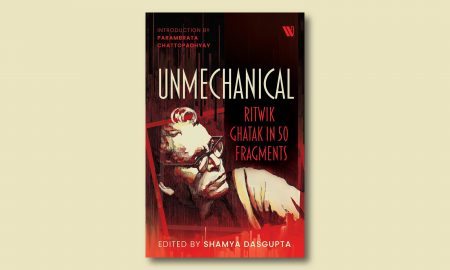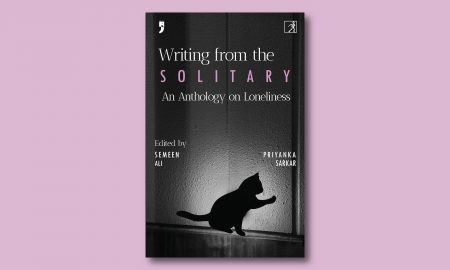Asit could only think when he was lying down. Without that, his brain and whatever little substance he had inside it just didn’t work! He thought about this fixation with the horizontal over the vertical long and hard, but it didn’t help that he was thinking about this while lying down. This way the horizontal had a field day! Verticality had practically no chance! Not that Asit didn’t get into trouble for this peculiar inability. Or was it an ability? Of course he got into trouble! His academic performance suffered big time. Finally, thanks to the system’s grace and someone saying, “OK, let’s give a chance to Asit,” he got permission to lie down on a bench and write his exams. Since then, he gave his exams alone. There were proctors, but he almost forgot what it was like to give an exam with others around him.
In his Linguistics minor in college, Asit came to know about the vertical and the horizontal axes of language. When we chose a few words from the vast pool of them in a language, that act was vertical. As we combined the chosen word nuggets into a sentence, that process made for the horizontal axis of language. Learning this made him wonder if his problem had something to do with language. But then again, do we always think in language? Aren’t there thoughts for which we have no words? What about thoughts we have in silence? Anyway, Asit did speculate about this. He couldn’t think from a vertical position. Did that mean he didn’t have the vertical axis of language? But how could that be? When he lay down, he could easily bring up words from a subterranean flow of language and string them together into sentences. How was it that this just did not happen when he was standing, sitting or walking? Imagine Asit’s social difficulties with conversation! He could never have a relationship or get married. The first time he lay down in front of a girl and told her that he could only talk to her lying down, she took it the wrong way and left immediately. On the other hand, the doctor who had no clue why Asit was the way he was, had to lie down in a bed beside him to offer that no-diagnosis. Asit lay still, thinking to himself how he had stumped medical science! But little did he know that his real encounter with medical science was yet to come! That doesn’t mean Asit knew about the epic chapter of something that was not (or was it?) a part of his life. We’ll see!
After countless struggles, when Asit became a schoolteacher in his own village, things hit rock bottom. Nobody believed him. Everyone thought he was lazy and didn’t want to do the work he was paid for. How could he tell them that it was impossible for him to teach standing, sitting or walking? He tried but not a single thought would ever appear in the poor hellhole of his mind! How could he teach without thinking? When folks around him finally understood that Asit wasn’t dodging work but actually had a problem thinking vertically, the classroom became a funny place. The school headmaster said, ‘OK, let’s give a chance to Asit.’ He was permitted to lie down on a bench; the students listened to him from their seated positions, lowering and bending their heads in all kinds of ways, just enough to give them untimely spondylosis. But the laughs vanished in time, as students realized how good a teacher Asit was when he lay down! Standing, sitting and walking, he could only stutter and mumble, but from a horizontal position, he could really think and think smart! His words came out in an impeccable chain.
There were evenings when Asit would lie down on the banks of the river and look unfailingly at the horizon—the line that separated the water from the sky. That is the line we humans call the horizontal. He tried to peek into the mystery of his mind by fixing his gaze at the horizon, at the limit of visibility. But all he saw were lonely birds taking flight to meet their flock after sunset. Asit did not have any flock awaiting him at the end of a long day.
But the real trouble came to Asit in his death! One auspicious or inauspicious day, in retirement’s cozy afternoon sleep, his 65-year-old heart suddenly stopped beating. Not one, not two, but seven long days thereafter, his brain simply refused to die! There was no brain death. Even the night of the full moon came and went, but his brain had other plans. Asit’s handful of friends who knew his predicament kept telling doctor Mahitosh Chattopadhyay that until and unless they made Asit’s body stand or sit, his head would perhaps not stop thinking. As long as there were thoughts inside the brain, how could it die? Asit’s death had given his friends an additional insight into his condition. Not only could he not think without being horizontal, but when he was horizontal, there was no way his brain could stop the train of thoughts. Asit may not want to think but the brain would still fire neurons and make him think. It thought for him, and thought relentlessly. His brain only relented when Asit stood up or got into some sort of a vertical position. All his life he felt he was marked for death. After all, only dead people lay down all the time! Horizontality belonged to the corpse. Asit had no inkling that it would be the other way round for him, that his body would resist death by thinking horizontally. Asit didn’t know that he was going to get reduced to a thinking corpse.
Dr. Chattopadhyay was originally from Asit’s village but as his practice picked up, he relocated to the city some years back. He approached Asit’s case when the government hospital in town contacted him to inform him about the strange proceedings. No brain death, days after the heart stopped! Dr. Chattopadhyay was intrigued by the case and took it up at once. He wasn’t sure what to do but at least wanted to be the medical witness to this extraordinary situation that was slowly unfolding. He kept Asit under observation in the hospital – he wasn’t convinced by the stupid rumours about the horizontal-vertical business – and continued to wait for the patient’s brain to die. Time passed. It became a stalemate.
Dr. Chattopadhyay was of course astounded by what had happened and the fact that he couldn’t understand at all why Asit’s brain didn’t die so many days after his heart had quit. He was a doctor. How could he believe the nonsense Asit’s friends were telling him? Having said that, no amount of neuroplastic resilience could explain what was happening in Asit’s brain. It was still thinking. His brain scans made that clear.
As another week passed, Asit’s body, now at the city mortuary, started showing signs of decomposition, but his brain still didn’t stop thinking. Dr. Chattopadhyay had become so fascinated by the case that he wanted to wait and watch further. The news spread and the media started reporting the case. It was everywhere from TV to social media, WhatsApp and what not! A whole Asit meme industry took off. Dr. Chattopadhyay consulted his seniors; he wrote emails to doctors from other parts of the country and overseas to discuss the case. In the end, he said to himself and the medical board he had formed, ‘OK, let’s give a chance to Asit.’
Avoiding media gaze as much as possible, Dr. Chattopadhyay instructed the mortuary to make a vertical cabinet for his body. In the middle of ice and preservatives, Asit’s body was made to stand up in the slot from midnight on a Saturday. Two hours from this vertical repositioning, thoughts ebbed in his brain. The scan showed signals of the last thoughts that were passing through Asit’s slowly darkening headscape. In the wee hours of the morning, after the much-awaited brain death had taken place at last, Asit’s body was secretly taken to the crematorium in a vertical position, in order to avoid another last minute twist in the tale. The funeral procession reminded Dr. Chattopadhyay of a similar procession he had seen in Mysore where the corpse was seated in a palanquin of sorts, carried by the near and dear ones. He couldn’t remember the name now but the cab driver had told him about the funeral practices of one such community. Asit’s body was placed on a special pyre that was fixed onto the wall of the burning ghat. With ropes, his body was tied to the pyre and set to fire. When the fire died down, there were severe burn-marks on the wall that had witnessed so many cremations over the years!
It didn’t take long because there wasn’t much in Asit’s body by that point. The only remnants were the dark desiccated marks on the surface of the half-burnt red bricks. These marks would share the story of Asit’s nearly endless horizontal thoughts with all the corpses that ever came to the last burning ghats of the world.
Dr. Chattopadhyay looked fixedly at the marks, etched by the fire. The sentence that surfaced in his brain from an unknown verticality of memory was Joseph LeDoux’s famous statement: “We are our synapses.”
Are we?
Photo by Martin Sanchez on Unsplash





